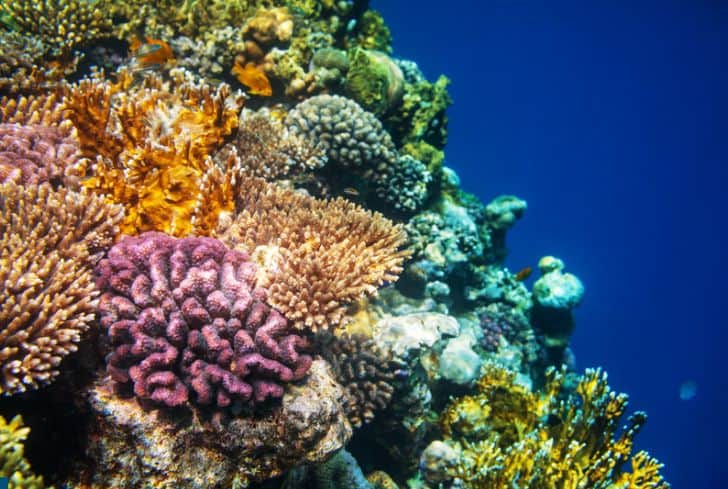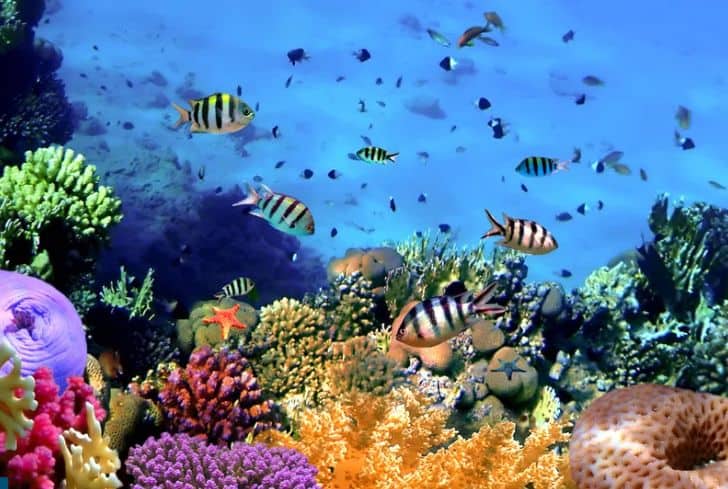Has a coral reef ever caught your eye? If so, you have got to have been captivated by its breathtaking beauty. They produce colorful proteins, which multiply when exposed to sunlight, which gives them their stunning hue.
However, do these reefs serve additional purposes besides enhancing the marine ecosystem’s beauty? You would be surprised to find out that coral reefs also produce oxygen which is crucial for humans. Read on to find out more.
What are Coral Reefs?
Large underwater structures known as coral reefs comprise the coral-like skeletons of migratory marine invertebrates. Hard or hermatypic corals, which obtain calcium carbonate from saltwater to construct an exoskeleton, are the types of coral that makeup reefs.
“Soft” corals are different species of coral that do not contribute to the formation of reefs. These flexible corals, including species like sea whips and fans, frequently resemble trees and plants.
The coral reef gradually grows larger over time, obtaining one little exoskeleton at each stage until they are substantial aquatic ecosystem components.
Typically, a coral reef looks out towards the ocean. The fore reef, which is to its seaward, descends into deeper waters and is floored farther below by reef fragments.
Behind the expanding fore-reef edge, which rises to around mean high-water level, is a low platform made up of fragments of dead reef structure or frequently colonized seagrasses.
Do Coral Reefs Produce Oxygen?
The earth’s atmosphere gets half of its oxygen from coral reefs, although they make up only 0.0025% of the bottom of the sea. The symbiotic link between an alga and corals called zooxanthellae makes this notable occurrence possible.
It is funny to think those reefs only cover a small percentage of the ocean floor, but they nonetheless generate a large amount of oxygen. They are essential for both human survival and the survival of aquatic life.
Coral reefs provide an accessible playground, shield coastlines from erosion and storms, and support local economies. They are also a source of food and medications. Over 500 million people rely on reefs for food, safety, and income.
Fishing, snorkeling, and diving on and around reefs generate millions of dollars for nearby businesses. Estimates place the annual net monetary worth of the world’s coral reefs in hundreds of billions of dollars.
Indigenous people worldwide place a great deal of cultural significance on these environments. If you count the corals and the creatures they sustain or just the corals, estimates range from 50 to 80 percent of all the oxygen on earth.
Whatever the case, there is no denying the importance of corals in maintaining the oxygen levels on our planet.
Corals occupy only a small portion of the planet’s surface, but they create at least fifty percent of the oxygen we require. We lose our essential sources of oxygen more quickly as the coral reefs are destroyed.

Types of Coral Reefs
We all know there is still much to learn about the maritime environment. However, thus far, we have identified four distinct varieties of coral reefs. Let us find out more about them all.
Barrier Reefs
Barrier reefs run parallel to a shoreline distinguished by a large lagoon or other body of water. The word “barrier” is used here to describe how these reefs, which reach the water’s surface at their shallowest point, act as a barrier separating the ocean and the coast.
The most famous barrier reef is the Great Barrier Reef in Australia. It is also the world’s largest barrier reef.
Atolls
Coral rings, known as atolls, generally produce protected lagoons in the middle of the ocean. Atolls typically develop when islands with fringing reefs collapse into the water or when the surrounding sea level increases.
Most atolls in the South Pacific are found in the middle of the ocean. Atoll structures can be found in significant numbers in the Indian Ocean. Atolls, on the other hand, are not common in the Caribbean.
Patch Reefs
Patch reefs are clusters of independent coral reefs connected by sand rings but are far apart. These reefs often occur in groups of 10 to 20 feet of water and are located in shallow lagoons.
The Caribbean Islands, Bermuda, the Pacific Islands, and the Bahamas are all frequent locations for patch reefs.
Fringing Reefs
Reefs that are “fringing” the shore have no “true” lagoon separating them from the neighboring land. Within the beach and the inshore margin of coral growth are frequently patches of the shallow subtidal and intertidal sand bottom.
Of the three primary forms of coral reefs, the fringing reef is the most prevalent, and there are several examples of it in each of the significant areas where coral reefs have developed.
Fringing reefs are typically susceptible to anthropogenic impacts because they lack an intervening lagoon.
How Do Coral Reefs Produce Oxygen?
Corals are not in charge of creating oxygen. However, they supply a habitat for zooxanthellae algae, which creates oxygen and distributes it into the nearby atmosphere.
As mentioned, zooxanthellae, an alga, and coral reefs work symbiotically to produce oxygen. However, do you know what a symbiotic relationship entails?
A symbiotic relationship is a close bond between two different living species. Both creatures interact in this kind of relationship, and at least one gains something from the interaction.
Yes, according to specific measurements, coral reefs are estimated to produce a more significant amount of oxygen than trees. Coral reefs are currently thought to create between 50 and 80 percent of the world’s oxygen, which means they do more efficiently than any tropical rainforest.
This is not to argue that protecting the rainforests is insignificant for maintaining the equilibrium and oxygenation of our atmosphere. However, it is crucial to recognize the significance of the reefs.
Dead zones develop in the water without enough oxygen, where nearly nothing can survive. To completely comprehend them, more research is required. They can happen for a wide range of reasons, like the widespread death of algae.
For the betterment of the earth, humans must, however, reduce their effect on the reefs.
Factors Affecting Oxygen Production in Coral Reefs
Rising sea temperatures, pollution, and other issues threaten corals and the whole reef ecosystem. The ability of corals to compete against quickly expanding meaty algae will ultimately determine their ability to withstand the strain these variables produce.
Below are the factors affecting oxygen production in coral reefs:
- Climate change
- Pollution
- Recreational misuse
- Ocean acidification
- Marine pollution
- Wrong fishing practices
Are The Coral Reefs Dying?
The most diversified ecosystems in the oceans and seas are coral reefs. However, this precious resource is slowly depleted due to several damaging human actions.
By 2050, all coral reefs are expected to be on the verge of extinction, according to scientists’ predictions, if things continue as they are. How does it affect us? The destruction of coral reefs can result in the atmosphere losing half of its oxygen content, which could endanger human life.
Below are some of the reasons why coral reefs are dying.
Warming Ocean Waters
The oceans absorb ninety-three percent of the warmth and energy produced by global warming. The oceans’ temperatures rise as a result of this heat absorption. Additionally, coral reefs have trouble thriving when the temperature rises.
Sadly, certain regions of the world now experience temperatures above 97 degrees due to global warming and rising ocean temperatures.
Ocean Pollution
Another threat to coral reefs is ocean pollution brought on by human activities and development. According to Collier, microplastics are among the principal contaminants, and when consumed by corals, they lead to diseases in coral reefs.
Additionally, physical plastic and trash in the ocean and hazardous chemicals contribute to ocean pollution. Corals are choked by these pollutants, which also prevent them from reproducing and alter the structure of the food.
Ocean Acidification
Ocean acidification, or the lowering of the ocean’s pH due to a rise in carbon dioxide in the atmosphere, is a significant element that damages coral reefs.
The list of chemicals released into the atmosphere due to the combustion of fossil fuels, CO2, and other substances is between 20 and 30 different. Everything trapped in the environment rains into the water through storms, further altering the pH equilibrium.
According to studies, variations in ocean pH can harm coral reefs, particularly the skeletons of those reefs. According to research, ocean acidification alone could cause a 20% decline in the bone density of Porites corals.
Coral Bleaching
Coral separates from themselves the oxygen-producing zooxanthellae when the ocean temperatures get heated. All of the corals that have been bleached turn white as a result of the corals having lost their natural color and food sources.
Corals can withstand bleaching, but they cannot withstand being stressed repeatedly.
Conclusion
This article has taught us the importance of coral reefs in maintaining the proper oxygen level in the atmosphere. Both our survival and the survival of aquatic organisms depend on these reefs.
Numerous factors, including pollution and global warming, directly or indirectly contribute to the decline of coral reefs, which may ultimately result in the extinction of humans as well. By lowering the carbon emissions causing global warming, we can do our part to conserve the coral reefs.






